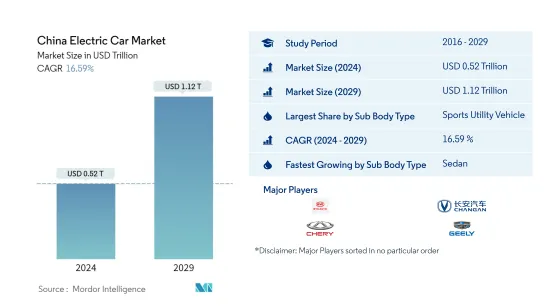Need help finding what you are looking for?
Contact Us
PUBLISHER: Mordor Intelligence | PRODUCT CODE: 1441536

PUBLISHER: Mordor Intelligence | PRODUCT CODE: 1441536
China Electric Car - Market Share Analysis, Industry Trends & Statistics, Growth Forecasts (2024 - 2029)
PUBLISHED:
PAGES: 193 Pages
DELIVERY TIME: 2-3 business days
SELECT AN OPTION
The China Electric Car Market size is estimated at USD 0.52 trillion in 2024, and is expected to reach USD 1.12 trillion by 2029, growing at a CAGR of 16.59% during the forecast period (2024-2029).

Key Highlights
- Largest Segment by Vehicle Type - Sports Utility Vehicle : Hatchback cars dominated the market mainly due to the introduction of various new models and growing focus on improved fuel economy and reduced exhaust emissions.
- Fastest-growing Segment by Vehicle Type - Sedan : The growing interest of people towards adventure and tough driving on various terrains and growing preference towards bold looks is driving the growth SUV in the passenger car segment in China.
- Largest Segment by Fuel Type - BEV : The extension of state subsidies through 2022 and the ongoing promotion of BEV adoption among Chinese people is major factors contributing to the rise of BEV in China's electric car market.
- Fastest-growing Segment by Fuel Type - FCEV : The governmental subsidies for BEV along with norms, continued encouragement of BEV adoption among private auto owners which is making BEV the fastest growing segment in passenger car sales in China.
China Electric Car Market Trends
Sports Utility Vehicle is the largest segment by Sub Body Type.
- China is one of the leading suppliers of batteries and has one of the largest markets for electric vehicles worldwide. One of the necessary and expensive parts of an electric car that impacts the overall price is the battery. In contrast, during the last 10 years, the average cost of lithium-ion batteries has decreased by almost 88% since 2010, and in 2021, the battery cost was USD 132 per kWh. The falling price of lithium-ion batteries is expected to reduce the cost of electric vehicles, and these developments are increasing the demand for electric cars in the country.
- China, the world's largest electric vehicle market, is backed by generous support from the government. China has extended the incentives related to purchasing new energy vehicles (NEVs) until 2022. In January 2020, Tesla Motors inaugurated a USD 2 billion facility in Shanghai that was assembling nearly 3,000 cars per week in March 2020, when all the other global facilities of the electric vehicle giant were shut down due to the COVID-19 pandemic. The sales of electric vehicles in China are expected to increase at a CAGR of 5.7% during the forecast period as a result of these successful and efficient model introductions, which will attract consumers looking for EVs that are affordable.
- Growing initiatives across the country by the government to develop charging infrastructure and investment plans by key players to develop EV technology are anticipated to boost EV demand in the market over the forecast period.
China Electric Car Industry Overview
The China Electric Car Market is fragmented, with the top five companies occupying 35.10%. The major players in this market are BYD Co., Changan Automobile, Chery Motors, Geely Motors and SAIC Motors (sorted alphabetically).
Additional Benefits:
- The market estimate (ME) sheet in Excel format
- 3 months of analyst support
Product Code: 93023
TABLE OF CONTENTS
1 EXECUTIVE SUMMARY & KEY FINDINGS
2 REPORT OFFERS
3 INTRODUCTION
- 3.1 Study Assumptions & Market Definition
- 3.2 Scope of the Study
- 3.3 Research Methodology
4 KEY INDUSTRY TRENDS
- 4.1 Population
- 4.2 GDP
- 4.3 CVP
- 4.4 Inflation Rate
- 4.5 Interest Rate For Auto Loans
- 4.6 Battery Price (per Kwh)
- 4.7 Electrification Impact
- 4.8 Shared Mobility
- 4.9 New XEV Models Announced
- 4.10 Charging Stations Deployment
- 4.11 Regulatory Framework
- 4.12 Value Chain & Distribution Channel Analysis
5 MARKET SEGMENTATION
- 5.1 Body Type
- 5.1.1 Passenger Cars
- 5.1.1.1 Hatchback
- 5.1.1.2 Multi-purpose Vehicle
- 5.1.1.3 Sedan
- 5.1.1.4 Sports Utility Vehicle
- 5.1.1 Passenger Cars
- 5.2 Fuel Type
- 5.2.1 BEV
- 5.2.2 FCEV
- 5.2.3 HEV
- 5.2.4 PHEV
6 COMPETITIVE LANDSCAPE
- 6.1 Key Strategic Moves
- 6.2 Market Share Analysis
- 6.3 Company Landscape
- 6.4 Company Profiles
- 6.4.1 BAIC Motors
- 6.4.2 BYD Co.
- 6.4.3 Changan Automobile
- 6.4.4 Chery Motors
- 6.4.5 Geely Motors
- 6.4.6 Great Wall Motors
- 6.4.7 Honda Motor Company
- 6.4.8 JAC Motors
- 6.4.9 Jiangling Motors Corporation
- 6.4.10 SAIC Motors
- 6.4.11 SAIC Motors
7 KEY STRATEGIC QUESTIONS FOR VEHICLES CEOS
8 APPENDIX
- 8.1 Global Overview
- 8.1.1 Overview
- 8.1.2 Porter's Five Forces Framework
- 8.1.3 Global Value Chain Analysis
- 8.1.4 Market Dynamics (DROs)
- 8.2 Sources & References
- 8.3 List of Tables & Figures
- 8.4 Primary Insights
- 8.5 Data Pack
- 8.6 Glossary of Terms
Have a question?


SELECT AN OPTION
Have a question?


Questions? Please give us a call or visit the contact form.
